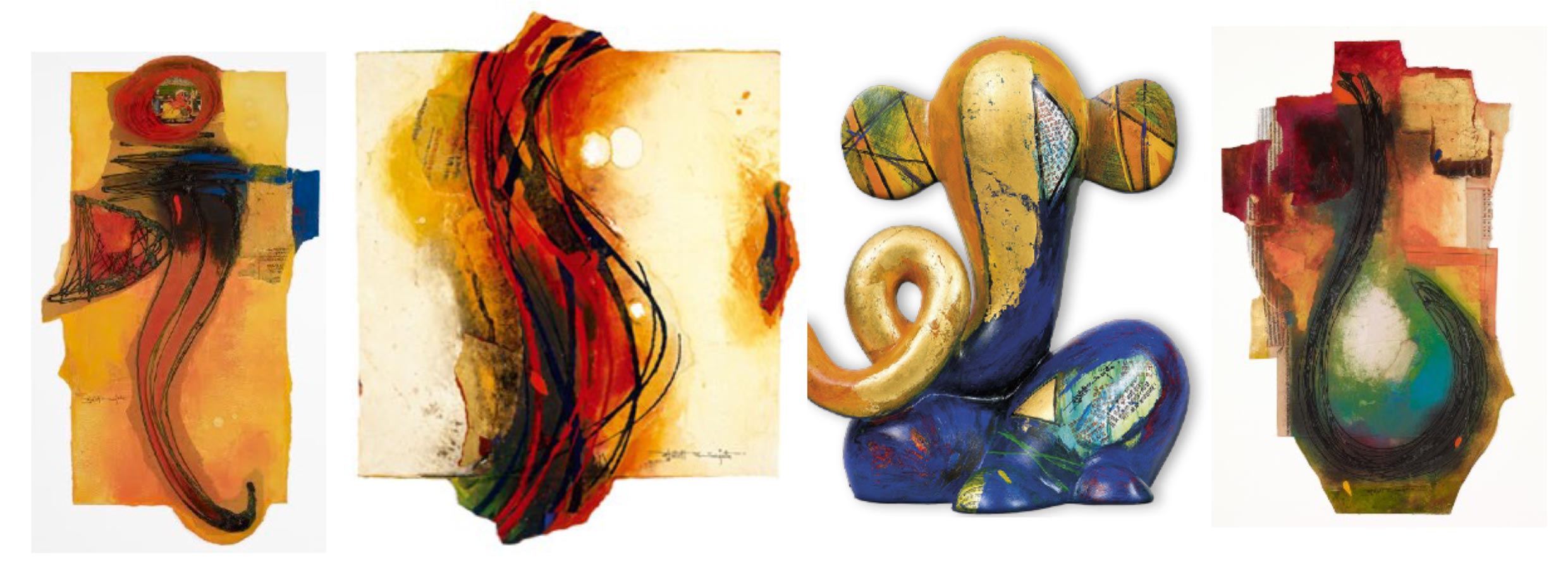Biography
Sujata Bajaj was born in on the town of Jaipur, one of India’s most appealing cities, where she spent her
childhood and adolescence. Her father Radhakrishna Bajaj had been on of Ghandi’s companions and a
disciple of spiritual master Vinoba Bhave. This tells us the quality of education she may have received. After
graduating from high school, Sujata plans for a while to study medicine but one of her elder brothers, a
surgeon, dissuades her from doing so as he have seen her draw and paint since she was a child. She therefore
enters the school of Fine Arts in Pune, where her work and determination earn her the first of her successes: a
gold medal to celebrate the end of her first stage of studies, first prize at a competition organized by the
university; Sujata isn’t yet twenty. At the end of her studies, having earned a master’s degree, she undertakes
the writing of a thesis on Indian tribal art and its influence the main tendencies of contemporary Indian art. It
must be said that tribal art, particularly in Rajasthan where it flourishes all around, could not fail to become a
major reference for all those who venture into the field of so-called modern art. 1988 is a turning point in
Sujata’s work and in her life. On Raza’s entreaties, after she meets him in Pune and he becomes both her
friend and her support, she applies for and is awarded a grant that will enable her to continue her studies at
the Paris School of Fine Arts where she enters the atelier of Claude Viseux. This painter and sculptor in
introduces her to the technique of monotype, encourages her to practice, so clear, it seems to him that this
might be the way of liberating forces in her, unbridling her energy and satisfying her innate taste for difficulty.
As she herself suggests, her monotypes are already “mixed media” like the ones she would produce later, and
still does; she combines in them all sorts of shapes and materials: torn papers, strings, fabrics, handprints and
even what looks like earth or sand, or more poetically, to borrow the title from Raymond Roussel, star dust.
Apart from Raza, other Indian contemporary artist have drawn her attention, — M.F. Husain, Ram Kumar
and Akbar Padamsee to name a few. One can probably notice in some other Indian artists, as in Sujata, a
profound dedication to colour, alternately violent and subtle and to its organization within the ideal expanse
of painting. Sujata did not have to feel her way for very long before throwing herself without restraint into
abstraction. Her earlier paintings perpetuate, with a degree of adaptation, the traditions of India’s tribal arts,
by the use of geometric and floral motifs, in the midst of which some stylized characters may appear, unless
they are placed under some star or planet’s blazing wheel - even if she. adjusts the elements she borrows from
her iconographic heritage to her personal vision. Very soon, however, ornamental or symbolic elements in her
painting yield to a more “classical” figuration, according to Western art’s criterions, albeit a figuration reduced
as it were, restricted in order to give way to vast surfaces of paint, whose subtle variations already announce
the later audacities of the literally abstract works. From 1983-1988, boldness of the composition on her canvases are remarkable.
Figurative elements - silhouettes, faces or women’s hands, details of architecture or
landscape — tend to become mere scansions of a writing that moves more and more towards pure
abstraction.

As early as 1990, vertical rectangular formats, which she has never ceased to favour since then,
tend to substitute themselves for usual square format. Verticality, stretching upwards, soaring, all this is
characteristic of some of Sujata’s compositions as well as of her very spirit, nourished with mantras, venerable
texts which she regularly incorporates into them as if to express the sacred content of her work. Because, if
there is any abstraction, it is not without substrate or intention.
Text Reference:
Excerpts from the book Sujata Bajaj La Differénce by Michel Waldberg published by SNELA La Difference
in 2009